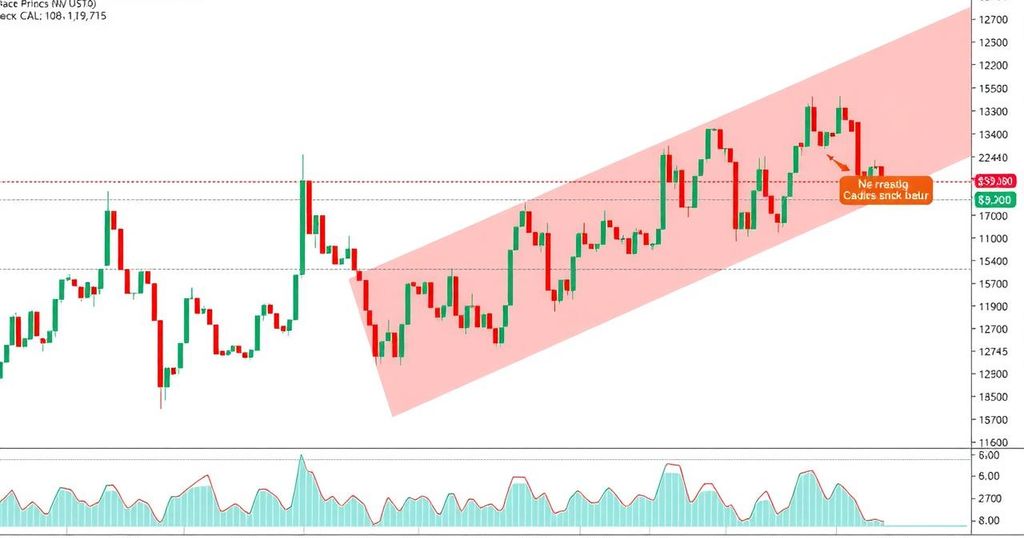Prospective Bitcoin Rally: Strong Market Indicators and Bullish Sentiment
Bitcoin price metrics suggest a solid foundation for potential new highs following a 9.7% surge from October 27 to October 29. The futures premium indicates strong investor confidence, despite recent corrections. Bitcoin’s market behavior is also intertwined with gold’s performance and macroeconomic data points, further informing the outlook for cryptocurrency markets.
Bitcoin experienced a notable surge, climbing 9.7% from October 27 to October 29, reaching a peak of $73,575 before retracting to the $71,500 level on October 30. Despite this minor correction, several indicators—including activity in derivatives markets, on-chain metrics, and demand for stablecoins—indicate a robust foundation that suggests the potential for a sustained rally beyond $73,000 in the near future. Furthermore, the Bitcoin futures premium, which serves as a crucial gauge of leveraged demand, reflects strong conviction among bullish investors. Under neutral market conditions, monthly futures contracts typically exhibit a 5% to 10% annualized premium due to the extended settlement period. Presently, the premium stands at 13%, marking its highest level in over four months, indicating that investor confidence remains intact despite the rejection of Bitcoin at $73,575. Bitcoin’s price trajectory closely followed that of gold, which initially peaked at an all-time high of $2,790 on October 30, only to lose momentum soon thereafter. This pullback in gold can be partially attributed to macroeconomic data released on the same date, including a private payrolls report from the United States, which indicated an increase of 233,000 jobs in October. Additionally, the US Bureau of Economic Analysis reported third-quarter GDP growth at 2.8%, slightly below the 3% growth reported for the previous quarter. Such economic resilience diminishes the chances of aggressive interest rate cuts by the Federal Reserve, thereby reducing immediate demand for alternative assets such as Bitcoin and gold. Moreover, despite a resilient economy, the demand for US government bonds does not necessarily experience an uptick. Concerns surrounding public debt have led to an increase in refinancing costs, with yields on the 5-year US Treasury rising from 3.5% to 4.1% over the past month. Amid skepticism surrounding the outcomes of US macroeconomic policies, Bitcoin’s ability to maintain stability in the face of short-term price corrections is noteworthy. Exchange net flow data reveals that there was a significant influx of deposits when Bitcoin surged past the $70,000 mark on October 29, indicating that some traders were inclined to take profits. However, according to data from Glassnode, this trend reversed by October 30, resulting in net outflows dominating the landscape. While some traders initially sold Bitcoin near its all-time high, this selling activity was short-lived and fell within conventional trading behaviors. The demand for stablecoins in Chinese markets provides further insight into market sentiment. A strong demand for cryptocurrencies typically elevates stablecoin prices to a 2% premium over the US dollar, while a discount often signifies apprehension as traders exit crypto markets. Recent data indicates that the stablecoin premium in China slightly decreased from 0.7% to 0.3%, remaining in a neutral range. Even with Bitcoin’s $2,140 correction on October 30, this information points to notable market resilience. Moreover, when observed alongside on-chain metrics and indicators from the derivatives market, there is substantial evidence suggesting that traders remain confident in Bitcoin’s capacity to uphold its bullish momentum moving forward.
The article discusses the recent performance and potential future movement of Bitcoin, highlighting various market indicators that suggest a sustained upward trajectory. It outlines the price fluctuations of Bitcoin, relationships with gold, and macroeconomic factors impacting alternative asset demands, particularly amid signs of economic resilience in the US. Additionally, the article examines trading behaviors related to Bitcoin and stablecoin dynamics, providing a comprehensive view of the current cryptocurrency landscape.
In summary, while Bitcoin experienced a minor price correction after reaching a new peak, various market indicators reveal a solid foundation for a potential rally above $73,000 in the near term. The high Bitcoin futures premium reflects strong bullish sentiment among investors, alongside supportive on-chain metrics and stablecoin demand, suggesting that traders remain confident despite recent price fluctuations. Furthermore, macroeconomic factors and gold’s price movements contribute to the nuanced understanding of Bitcoin’s resilience and potential for continued bullish momentum.
Original Source: cointelegraph.com







Post Comment